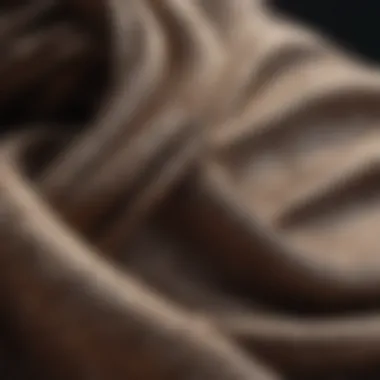Top Brands Redefining Baggy Clothing Trends


Intro
Baggy clothing has established itself as a prominent element in contemporary fashion, appealing to a broad range of preferences. Its comfort and versatility cater not just to casual outings but can also transition to more semi-formal settings. This section explores the current trends, styles, and the impact of various brands specializing in baggy fashion.
Trend Report
Latest Fashion Trends
Recently, baggy clothing has shifted from a niche subculture to a mainstream choice. Major runway shows have showcased oversized silhouettes paired with tailored materials. This trend highlights an increasing comfort-first approach that many brands are adopting. Moreover, a mix of streetwear influences has encouraged bold designs and vibrant colors.
Seasonal Trends
Adjusting to seasons, baggy styles evolve accordingly. In spring and summer, lightweight and breathable fabrics dominate, allowing for comfort in warmer climates. In fall and winter, thicker materials such as wool and fleece become popular. Layering becomes essential for both warmth and style.
Style Guides
Wardrobe Essentials
When it comes to baggy clothing, key pieces should be part of every women's wardrobe:
- Oversized t-shirts
- Baggy jeans,
- Loose-fit jackets.
These staples can mix and match easily, creating versatile outfits.
Styling Tips
Mix and match oversized apparel with fitted pieces to create balance. For instance, pairing a baggy sweater with slim-fitting trousers can create a sophisticated look while still prioritizing comfort.
Product Reviews
Fashion Reviews
Leading brands in this genre include Chanel, known for elevated yet laid-back styles, and Oversized, specializing in bold statement pieces. Their collections not only push the bounds of conventional fashion but also maintain wearability.
“Comfort does not have to sacrifice style. The right baggy piece can elevate any outfit.”
Celebrity Fashion & Beauty
Celebrity Style Icons
Celebrities like Billie Eilish and Harry Styles have normalized baggy fashion in the public eye. Their fearless styling choices influence widespread acceptance among fans.
Preamble to Baggy Clothing
The landscape of fashion is diverse and ever-changing, and baggy clothing represents a significant aspect of contemporary styles. This section delves into the significance of baggy attire and sets the stage for the broader exploration of leading brands focused on this genre. In a world where individuality and comfort increasingly operate in tandem, baggy clothing stands as a testament to both personal expression and practicality.
Definition of Baggy Clothing
Baggy clothing typically refers to garments characterized by loose fits and relaxed shapes. This attire contrasts sharply with more tailored designs, allowing for freedom of movement and offering an alternative to conventional styles. Common items include oversized t-shirts, wide-leg pants, and loose hoodies. As everyone values comfort in their choices, individuals often gravitate toward these designs for casual wear.


Historical Context of Baggy Fashion
The emergence of baggy styles can be traced back to various cultural shifts throughout history. In the 1990s, grunge and hip-hop movements popularized oversized silhouettes as a form of rebellion against mainstream fashion norms. For many, baggy building represented a statement of non-conformity within the confines of traditional style. Since then, it has evolved, permeating various fashion circles and continuing to influence trends.
Cultural Influences Shaping Baggy Styles
Cultural influences play a critical role in the crafting and dissemination of baggy clothing styles. Different communities have generated garments that not only focus on comfort but incorporate cultural narratives as designs inspire and speak to distinct identities. The influence of music, streetwear, and even lifestyle movements contribute to how we perceive baggy styles.
Baggy clothing not only prioritizes comfort but also reflects cultural narratives and individual identity.
By observing these elements, we come to understand why baggy clothing has deeply resonated with various demographics, notably among the younger generations and even in the general populace, who seek a more versatile and expressive way to dress.
The Appeal of Baggy Clothing
The notion of baggy clothing represents more than just a passing trend. Its appeal rests on varied pillars that resonate deeply with consumers today. At the heart of this fashion movement is a desire for comfort intertwined with a distinct aesthetic identity. Baggy clothes serve as a response to the increasingly fast-paced and stressful lifestyle, providing a reprieve with ease and freedom of movement. Thus, important aspects of baggy clothing include its comfort level, versatility, and the powerful individual expression it allows.
Comfort and Versatility
One of the foremost reasons baggy clothing stands out is its unparalleled comfort. Manufacturers adopt soft, breathable fabrics that foster ease of wear. Styles such as oversized sweatshirts, looser dungarees, or flowy, wide-leg pants offer a fit that conforms to numerous body shapes. This, in combination with approachable silhouettes, has garnered enthusiastic support across various demographics.
Versatility further enhances this comfort appeal. Baggy clothes can transition effortlessly from casual outings to more upscale events when paired thoughtfully. Layering options also expand the styling possibilities, inviting wearers to blend functionality with fashion. Combine baggy joggers with a fitted top, or style an oversized trench coat over a form-fitting dress. Each outfit reiterates the potential of varied baggy items.
Fashion Statement and Individuality
In contemporary discourse, fashion acts as a vehicle for personal expression. Baggy clothing epitomizes this notion by offering a blank canvas where individuals can showcase their unique styles. Brands design collections that draw inspiration from streetwear, retro influences, and cultural motifs, allowing people to carve statements that reflect inner selves.
Looser fits create compelling contrasts with more structured garments, enabling bold separation in one's wardrobe. A consumer can mix designs, colors, and textures. The variety imbues a sense of originality that stands distinct in crowded urban landscapes. Consequently, by weaving in personal narratives with their wardrobe choices, individuals engage deeply with their aesthetic journeys.
Gender-Neutral Appeal
Baggy clothing excels in dismantling traditional gender norms that dictate specific styles to different groups. Today, many brands embrace designs that are gender-neutral, appealing widely and promoting inclusivity. It is empowering when individuals wear what makes them feel good, irrespective of conventional standards.
This gender-neutral stance promotes a spirit of unity amidst diversity in style and preference. People of all gender identities find resonance beneath the garment silhouettes, fostering not just community, but a broader dialogue concerning empowerment in fashion.
As baggy attire continues to carve its niche, the possibilities it uncovers are numerous. At the intersection of comfort, individuality, and inclusivity, it profoundly shapes the way current fashion entertains and empowers.
Key Baggy Clothing Brands
In the contemporary fashion landscape, the discovery of key baggy clothing brands holds significance that stretches beyond mere style choices. These brands not only define comfort but also establish individualism within a fast-paced, ever-evolving industry.
Understanding which brands lead the baggy clothing sector adds value to anyone seeking to embrace a more relaxed aesthetic. There are several considerations when identifying truly impactful brands. Trends in consumer preference have shifted, with comfort taking precedence, demanding attire that does not compromise on ease, nor on personal expression.
Overview of Leading Brands
Leading brands in baggy clothing tend to fuse aesthetics with functionality. These companies typically have a solid grasp of what modern consumers want, taking into account not only the look but the entire wearing experience. studying their designs will show an emphasis on loose fits and airy silhouettes, tailored to facilitate both movement and style.
Several notable names in this sector have distinguished themselves through excellent craftsmanship and attention to detail.
Brand Profiles


Brand A: History and Vision
Brand A has remained a frontrunner in the baggy fashion space. Founded in the early 2000s, Brand A has adapted its mission over time. The company's history shows an early engagement with street style, evolving to match consumer demand as well as cultural shifts. The vision of Brand A revolves around inclusivity and accessibility, ensuring that their pieces are readily available to a diverse range of individuals. Their commitment to various demographics is a hallmark that gives them a unique position in the fashion industry. This focus makes Brand A a robust and reliable option for fans of baggy clothing.
KeyCharacteristic: Reality Engagement Focused
Brand A puts emphasis on community and engagement rather than solely on profits, making it attractive due to its conscious business model.
Brand A: Key Offerings
The product line of Brand A showcases a wide selection of clothing that embodies comfort and style. This inclusion of pants, oversized tops, and outerwear provides excellent versatility. Brand A is tended towards balanced designs which make it easy for wearers to mix and match different pieces.
Unique Feature: Collaborative Designs
They often engage in collaborations with artists or influencers, which keeps their offerings fresh and relevant in the market.
Brand B: Evolution of Style
Initially rooted in casual wear, Brand B has undergone significant transformation year after year, enhancing its baggy designs to reflect changing aesthetic preferences. Known for their innovative styles, Brand B offers fresh takes on quintessential classics. This tactical evolution has contributed greatly to the company's relevance.
Key Characteristic: Adaptive Identity
The company exists in harmony with trends while maintaining their core identity; this keeps consumers returning since there is always something new to see.
Brand B: Target Audience
Brand B specifically appeals to a younger audience, notably millennials and Gen Z, who prioritize self-expression through fashion. The brand understands the necessity for contemporary groups to reflect personal values through their choices. Their pieces promote traits of non-conformity, which hold harnessed intrigue for its followers.
Unique Feature: Customization Options
They offer customization features, allowing customers to put elements of their personality directly into items.
Innovative Approaches to Baggy Clothing
Within the world of baggy clothing, innovation plays crucial role in evolving the typical ideas surrounding what 'baggy' should look like. Advances in materials signify changes in construction processes that impact both style and comfort. Brands that capitalize on advancements provide consumers options that adhere to modern sensibilities while retaining the practical benefit of wearing loosely fitted garments.
As awareness for sustainable practices grows, so has the infiltration of these eco-aware fashions into mainstream consumer habits. Shaping how consumers think about fashion, these brands provide a platform commandments expanding the ideals behind baggy clothing beyond mere aesthetics into considered style solutions.
Sustainability in Baggy Fashion
Sustainability in the fashion industry has become an increasingly critical issue. As the global demand for fashionable, comfortable clothing rises, it is essential that consumers and brands alike consider the environmental impacts of fabric production and garment manufacturing. Baggy clothing brands, known for their relaxed styles and comfort, have the opportunity to lead by example in the realm of sustainability. This section will explore specific elements of this topic, including the use of eco-friendly materials and ethical production practices.
Eco-Friendly Materials
A significant aspect of creating sustainable baggy clothing is the materials used in production. Eco-friendly materials not only benefit the environment but also enhance the quality of garments. Innovations in fabric technology have led to the development of a wide range of sustainable options, popularly including:
- Organic Cotton: Unlike conventional cotton, organic cotton is grown without harmful pesticides or synthetic fertilizers. This practice has less water usage and promotes healthier agriculture.
- Recycled Polyester: Made from reclaimed plastic bottles and textiles, recycled polyester helps reduce waste. Brands that use this material are actively working to reimagine fashion while promoting environmental benefits.
- Tencel: A fiber derived from sustainable wood sources, Tencel is biodegradable and produced using environmentally friendly processes to minimize water and energy use.
By prioritizing these eco-friendly materials, baggy clothing brands can minimize their carbon footprint and contribute to a more sustainable industry.


Ethical Production Practices
Just as important as the materials used is how clothing is made. Ethical production practices encompass a wide range of principles aiming to ensure fair labor conditions and transparency within supply chains. Several elements characteristic of ethical practices include:
- Fair wages for workers: Ensuring that garment workers receive fair compensation for their efforts is essential in building a just industry. Many brands actively advocate for this, creating models of sustainability that consumers can trust.
- Safe working conditions: Clothing production facilities must comply with safety regulations and provide workers a safe working environment, essential for well-being and productivity.
- Transparency: This practice involves brands revealing their supply chains. Knowing where products are sourced and who is involved in the process increases consumer awareness and trust.
Supporting ethical practices contributes to a healthier society. As more baggy clothing brands embrace sustainable options, the potential for meaningful change in the industry grows.
Ethical choices in fashion matter. Sustainability cannot happen if we ignore the people behind the products.
Establishing strong foundations in sustainability is fundamental not only for attracting a discerning market but for aligning with a future where fashion remains respectful of the environment and our global society.
The influence of these changing preferences requires keen attention and deep understanding of target customers. As baggy clothing merges into mainstream fashion, brands must be nimble and ready to pivot swiftly.
Future Trends in Baggy Fashion
The future trends in baggy fashion are becoming crucial in understanding how clothing reflects societal shifts and acts as a canvas for individual expression. With growing interests in comfort and a departure from restrictive styles, baggy clothing is not merely a trend, but a significant predictor of how we perceive fashion's evolving landscape. Essential to this discussion are key elements such as consumer preferences, sustainability, and technological advancements that are reshaping the industry.
Predictions for Baggy Clothing Popularity
Current trajectory points towards an increase in the popularity of baggy clothing. This happens as more brands embrace loose fits that cater to a wider array of body types. Not only does baggy clothing offer physical comfort, but its growing acceptance reflects our cultural shifts toward casual and relaxed styles.
Factors Influencing Popularity:
- Comfort-driven choices: The ongoing shift toward work-from-home models emphasizes comfort in daily wardrobes.
- Inclusivity in fashion: Baggy styles often convey a sense of ease and acceptance, enabling fashion that fits numerous body shapes.
- Cultural movements: With rising movements focused on individualism and self-expression, fashion emerges as a means to showcase unique tastes, rather than conforming to traditional silhouettes.
The future of baggy clothing is certainly promising. As our lifestyle changes and cultural attitudes evolve, this fashion style could assume an increasingly significant role in our collective wardrobe choices.
Influence of Technology on Design
Technology is increasingly carrying a hand in the way baggy clothes are designed and produced. Innovations in fabric manufacturing and design software enable brands to introduce new types of materials and fits that further encapsulate the ethos of baggy attire.
Key Technological Influences:
- Advanced fabric development: New coated fabrics offer greater durability while remaining light and comfortable. Brands can explore new textures and technologies that join aesthetics with practicality.
- Design software: Tools like CAD are reshaping the design process, allowing for rapid prototyping, which speeds the creation of new styles, celebrating unique shapes and proportions.
- Sustainable production practices: Technological advancements render eco-friendly manufacturing processes more accessible, marrying the commitment to nature with consumer desires for on-trend clothing.
"Fashion is not just about clothing; it’s a shared language that represents our culture and choices."
Listening to the global conversation surrounding comfort, body positivity, and sustainability shapes predictions for the future of baggy fashion. Neither a fleeting trend nor an ephemeral identity, the expansion into baggy clothing ultimately possesses the sustained resonance of self-expression in a world increasingly characterized by rapid change.
The End
Recap of Baggy Fashion Evolution
Baggy fashion has undergone significant changes over the decades. Originally defined by loose-fitted garments for comfort, this style has been influenced by many cultural movements and icons. In the 90s, for example, hip-hop culture played a pivotal role in popularizing oversized clothing. Grunge aesthetics followed, further enhancing the trend with an focus on anti-establishment vibes. Now, we see elements of these genres coming back to blend with modern designs, revealing a continuous cycle of reinterpretation.
Fashion’s landscape remains dynamic, and the enduring appeal of baggy clothing points to its adaptability. Designers have responded to consumer desire for relaxation and ease showcased in oversized silhouettes, ensuring this style adaptpts to various contexts from streetwear to more refined wardrobes.
Final Thoughts on Brand Importance
The brands highlighted throughout this article are more than just names. They represent a forward-thinking approach to fashion that centers on versatility, sustainability, and comfort. As societal norms shift, the relevance of baggy clothing continues to increase. Today’s consumers prioritize authenticity and comfort, making it vital for brands to connect with these values.
In this light, established names and new entrants in the baggy clothing market position themselves strategically to capture the evolving tastes of shoppers. Their commitment to innovative designs and sustainable practices serve not only their businesses but also push the collective narrative of what fashion can be in a contemporary context.
To be succesful, brands must navigate trends while nurturing their unique philosophies. The successful integration of functionality and aesthetics will likely define the next chapter of baggy fashion.
Consumers should reflect consciously on their choices. Supporting brands that align with personal values causes greater impact across the fashion industry. Overall, the impression left by baggy brands is not just of style, but of thoughtful evolving connections to society.



